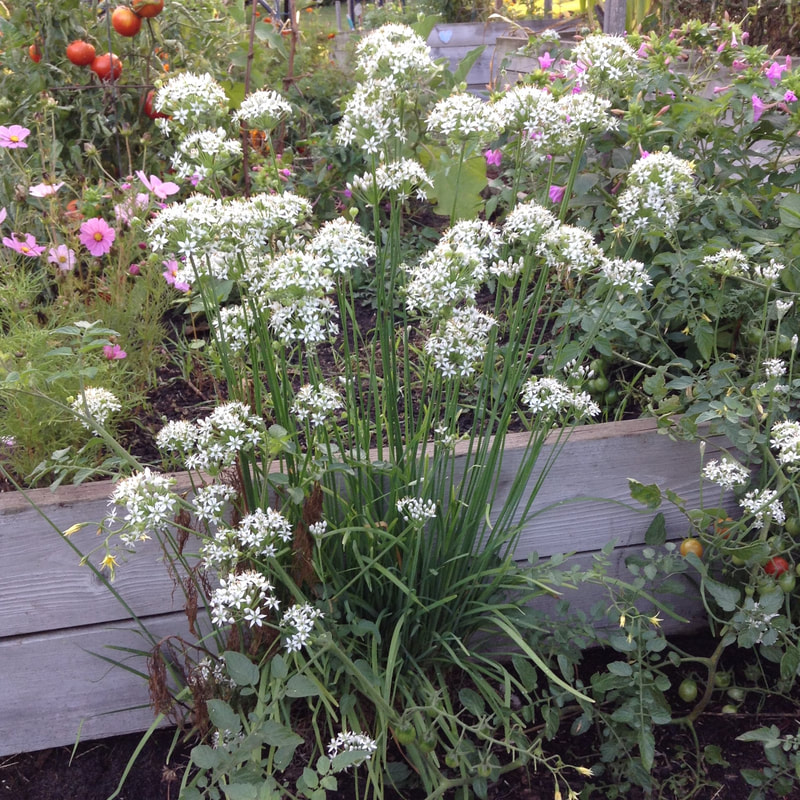|
Photo and article by Donna Iverson
Garlic chives are pretty and edible. Easy to grow. A heritage plant with a long history. And they escape to the wild at every opportunity. My kind of plant. Sometimes called Chinese leaks, as that is where they originated thousands of years ago, garlic chives are a perennial usually grown from seed in the spring. Garlic chives are both a veggie and an ornamental for many types of gardens, including rock gardens, kitchen gardens, white gardens, medicinal gardens or as a container plant. More garlic than chive, they, nevertheless, belong to the onion family, Allium. Unlike regular garlic, these plants have no bulb underground. Come fall, they will self-seed and the next year, the harvest will double. In fact, they can become invasive. They are winter tolerant so you will have a supply year round. Both the flowers and the stems are edible. At the most basic, you can just snip tiny pieces of stem onto a salad or use as a sandwich enhancer. Toss them into soups, stews, stir fries or your scrambled eggs. Add during the end of the cooking process to retain their fresh flavor. Garlic chives are rich in Vitamins A, B6, B12 and C, along with potassium, calcium and Carotene. In Chinese medicine, garlic is one of five healing foods along with onion, lemon, red peppers, and honey. The plant contains antifungal, antiparasitic, and anticarcinogenic agents. It is also an antioxidant and may help reduce blood pressure. In Celtic times, garlic was hung in doorways on Halloween (Samhain) to ward off evil spirits. I suspect garlic chives would work just as well and look a lot better. And if you could care less about garlic chives as either food or medicine, it may appeal to your artistic sensibilities. It did to Vincent Van Gogh who painted Flower Pot with Garlic Chives 1887. The painting hangs in the Van Gogh Museum in Amsterdam and can be seen online at https://arthur.io/art/vincent-van-gogh/flowerpot-with-garlic-chives?crtr=1 Seeds of Garlic Chives are available from Baker Creek Heirloom Seed Company, at [email protected] or calling 417.924.8917 in Missouri.
0 Comments
Photo and article by Donna Iverson
Last summer, a vendor was selling slices of watermelon at the Muskegon Farmers Market. I almost always sprung for one because a full size watermelon was too heavy for me to carry. But this fall, several market vendors are selling personal-sized round watermelons that weigh about 5 pounds. I’m hooked and they are delicious. Earlier in the summer, the round watermelons were yellow inside, almost like a large cantaloupe. By August, red flesh ones appeared, and like the yellow ones, they were seedless. Well not really seedless, they contained small white seeds that were edible and hardly noticeable. I was intrigued. Were these a new variety of watermelon?? And why had they suddenly become popular? Turns out, they haven’t suddenly become popular but have been growing in popularity for the last 15 years. My guess is that they fill a need as they are easier to carry and can be consumed by one or two persons at a meal. The trend in watermelons is definitely toward a smaller and smaller size. These small round watermelons are called icebox watermelons and can weigh between 5 and 15 pounds. They fit in your refrigerator and are perfect for a small family. Locally, I’m also seeing more and more small round watermelons growing in neighbors’ gardens. According to growers, they are not that difficult to grow nor does it take a huge garden space. Their best advice is to grow round watermelon from seed and I would recommend an heirloom variety. The basic requirements for growing include warm soil, three months of hot sunny weather, and frequent watering and feeding. More details on growing, watermelon, their pests and harvesting can be found at tropicalpermaculture.com As for the history of the watermelon, amazingly it goes back 5000 years to Africa. There, watermelon grew in the wild, and was originally round. Egyptians breed these wild fruits to increase their sweetness, eventually turning the pale yellow insides to bright red. The redder the melon, the sweeter the taste. They also favored the oblong shape. Interesting watermelon facts:
|
Archives
July 2024
Categories |


 RSS Feed
RSS Feed